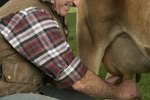
If you like the idea of your dairy products coming from happy cows, you might have entertained the idea of bringing one or two bovines home, feeding them well and piping Mozart over speakers wired into the barn. While that would make for a couple of contented cows, their care extends beyond that. Specifically, cow udder care is a real concern, whether you have 2 or 200 dairy cows. Know the basics to avoid problems.
Before and After Milking
Your cow's udder should be cleaned, teats and all, before you begin milking her and then again when milking is through. Running water is a simple, efficient way of accomplishing this. Iodine or other disinfectant can be added to increase the effectiveness of the wash. Dry the teats and udder with a paper towel. Disposable towels are preferred for this job, as reusing towels after milking or to dry the udders of other cows could spread contamination. If you're using a milking machine to milk your cow, you can dip her teats in a disinfectant before attaching the machine and then again when the milking machine is removed. Take care to wipe the teats completely dry with paper towels before the milking machine is attached. If you are hand milking, just be sure to thoroughly wash and disinfect your hands before starting.
Caring for Scratches and Scrapes
Because they're large, awkward and located where they are, your cows' udders run the risk of minor injury all the time. Milking machines, insufficient bedding -- even your cow's feet can bruise or scrape her own udders. Treating your cow's udder with disinfectant before and after milking will help heal scrapes and scratches that might be present on the teats or anywhere else on the udder. Dip each teat individually in disinfectant and treat even the smallest wound by blotting (not rubbing) with a cotton pad. Painful, open wounds can be treated with a pain-relieving ointment and covered with medical tape. In such instances, contact your veterinarian to treat your cow and determine whether the wound requires more than simple bandaging.
General Hygiene
Proper udder care and controlling the problems that plague cows and their udders extends to managing the surroundings and keeping your cows well groomed and clean. Keeping your cows' hooves and dewclaws trimmed will cut down on self-inflicted injuries. The girls will get an udder bath before and after milking, but a thorough, full-body hose-down once a week or less, depending on how dirty they get, will help keep your cows and their loafing spaces clean which, in turn, will help keep udders clean and disease-free. Proper bedding for the space should be a material that is flexible, soft and should not promote bacterial growth. Examples of natural materials that are appropriate for your cows' bedding include sand, shavings dried in a kiln or even dried manure. Soiled or wet bedding should be removed daily and replaced with fresh.
Udder Conditions to Watch For
Two common cow udder conditions to keep an eye out for during routine care of your cows are mastitis and udder scald. Both cause physical signs on the udders and can affect the amount of milk a cow produces. Look for redness and swelling on the udder, sensitivity during milking or when the udder is touched, dehydration, diarrhea and loss of appetite as signs of mastitis. Udder scald is a condition similar to a yeast infection of the skin that appears where the udder rubs against her upper thigh. You'll recognize udder scald because it appears as a moist rash and has a distinct, rank smell to it. At the first signs of either condition -- or whenever you notice anything out of the ordinary regarding your cows' health -- contact the vet for consultation and treatment.
References
Photo Credits
-
Digital Vision./Digital Vision/Getty Images
Writer Bio
Elle Di Jensen has been a writer and editor since 1990. She began working in the fitness industry in 1987, and her experience includes editing and publishing a workout manual. She has an extended family of pets, including special needs animals. Jensen attended Idaho and Boise State Universities. Her work has appeared in various print and online publications.



